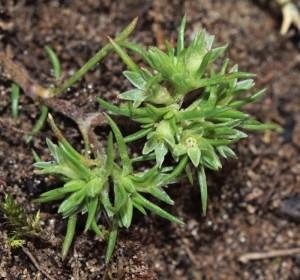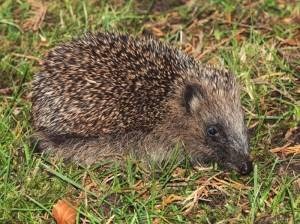Dr Phil Smith’s Wildlife Notes
November 2010
It’s not often that November produces a new wild-flower for the sand-dunes. Visiting Birkdale Common on 1st to complete a botanical survey, I spotted a low-growing plant that I didn’t immediately recognise. It turned out to be Annual Knawel (Scleranthus annuus), thought extinct in South Lancashire since 1986 and not seen in Sefton since 1914! Looking a bit like a Pearlwort (Sagina) with small greenish flowers, this is a fairly widespread plant in Britain but has declined so much since 1950 that it is now Red Data Book listed as “Endangered”.

Birkdale Common lies near the eastern fringe of the dune system where centuries of rainfall has washed the lime out of the soil, producing a dry acidic grassland, this being exactly the habitat favoured by Annual Knawel. During the month, I made further visits with friends to record more details. We counted about 250 mature plants, mainly on the western slopes of a large sandy mound. The habitat is maintained by occasional mowing, recreational trampling and summer drought, creating a short sward with plenty of bare patches suitable for colonisation by this short-lived plant. Other notable species found on the Common include Narrow-leaved Parsley-piert (Aphanes australis), Bird’s-foot (Ornithopus perpusillus) and Corn Spurrey (Spergula arvensis). In addition, Dave Earl tells me that Hoary Cinquefoil (Potentilla argentea) grew here from at least 1950 to 1995 but has not been seen in recent years. We must look out for it next summer.
The Common is not designated for its wildlife interest and perhaps merits inclusion in Sefton Council’s register of “Sites of Local Biological Interest” under the Unitary Development Plan.
On 10th, I went to see the Council’s scrub clearance project on Birkdale Sandhills Local Nature Reserve. Concentrating mainly on the invasive Sea Buckthorn, the staff have an enormous job on their hands bringing the area back to how I remember it 40 years ago, when the landscape was much more open, largely free of scrub and rich in duneland wildlife, such as the Natterjack Toad. Walking back along the Green Beach, I had superb views of nine Redpolls feeding in the Alders. This bird used to be much commoner in the dunes than it is now, the British population having declined by 89% between 1970 and 2001.
An adult Hedgehog foraging on my lawn on 18th was a surprise, as it should have been hibernating. I hope it retuned to its hideaway before the cold weather set in a few days later.

Calm, clear weather on 22nd provided ideal conditions for a Formby Point sea-watch. Derek Forshaw tells me he hit a “purple patch”, with Velvet Scoter, Long-tailed Duck, 10 Scaup, 14 Eiders, 100s of Common Scoters, 4 Shags, 5 Red-throated Divers, 13 Great Crested Grebes, several Guillemots, Razorbills, Gannets and Red-breasted Mergansers and a single Kittiwake. What a selection!
Plenty of rain during October and early November flooded some of the deeper dune slacks but, as a result of the earlier winter and spring drought, we still have a long way to go to get back up to normal water-levels. Nevertheless, I was pleased to find 97 Common Snipe, 3 Jack Snipe and a Water Rail during a visit to Cabin Hill on 19th. The salt-marsh at Weld Road, Birkdale, can also be productive at this time of year. Slogging across the marsh in freezing conditions on 26th, I counted 34 Common Snipe, single Jack Snipe and Little Egret, a pair of Stonechat and, finally, a flock of about 90 mixed Linnets and Twite. Yelping Redshanks kept flushing the flock, so I couldn’t get close enough to distinguish between the species, though from the calls I reckoned they were mostly Twite. Unfortunately, the national Waxwing invasion had still not reached us by the end of the month, the nearest flocks I heard about being in Preston and Horwich.
